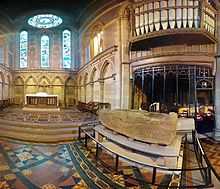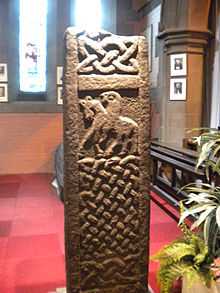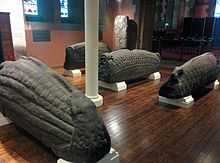Govan Old Parish Church

Govan Old Parish Church was a parish church in the Church of Scotland, serving Govan in Glasgow. It was also known as "St Constantine's". Since 2007, the congregation has become part of Govan and Linthouse Parish. Govan Old Church is no longer used for regular Sunday services, but the building remains open and is used for occasional services, including midweek services. The dedication is to Saint Constantine of Strathclyde whose shrine at Govan is still in existence.
Creation of the Site
It is believed that the earliest Christian origins of the Govan region emerged in the 6th century, but the Govan Church rose to prominence in the 9th and 10th centuries. The local rulers of Strathclyde became allied with the English, Scots, and Northumbrians to defend themselves from Viking raids. Their central fortification, Dumbarton Rock, was attacked in 890, resulting in the movement of the seat of power to Govan. This led to the establishment of the church site across the river from the royal estate at Partick. There is evidence of these royal associations in the graveyard, which is unusually large for the area and time period and suggests that the site was created by many wealthy landowners. Because the site has been in continual use since this first establishment, it is impossible to tell what the original church looked like, but it is clear from a lack of change to the site of the graveyard that the burial ground always had Christian associations.
Building

Govan Old Parish Church is an ornate, Category A listed building[1] of significant architectural merit, designed by Robert Rowand Anderson and influenced by features at Pluscarden Abbey near Elgin. Govan has, however, known considerable socio-economic problems and has been severely affected by the decline in the shipbuilding industry.
The current church building was constructed in 1888, although the site is one of the oldest places of Christian worship in Scotland, in continuous use since the 6th century. Upon construction, the congregation was closely associated with the Scoto-Catholic High Church movement within the Church of Scotland—several former ministers have been actively involved with the Scottish Church Society. Notable former ministers include the Reverend George MacLeod, later the Lord MacLeod of Fuinary, and Norman Shanks, Leader of the Iona Community from 1995 to 2002.
Two of the church's windows were given by Robert Malcolm Kerr; the Emmaus window in 1891, and Christ blessing the children in 1902. Both were made by Heaton, Butler and Bayne.[2]
The church's collection of early Christian carved stones is of international significance. 31 monuments survive, most of which are highly decorated. They mostly consist of recumbent cross-slab grave markers that date from the 9th and 10th centuries. 21 cross-slabs still remain and 16 are known but have been lost, potentially buried somewhere in the graveyard.

Rarer and more elaborate stones include Viking hogback tombstones, carved crosses and a carved sarcophagus.[3]
Govan Sarcophagus
The Govan sarcophagus, a massive stone coffin with a carved exterior, is supposed to have been dedicated to the patron saint of the church, St. Constantine. There is a lot of debate over which Constantine is the patron or Constantine of Strathclyde, but most scholars agree that the coffin most likely would have been dedicated to Constantine f. Kenneth (AD 862-878) or Donald f. Constantine (AD 889-900).[4] Because of its highly decorated exterior, it is assumed that the coffin was meant to display the remains of the saint as a focal piece in the church.
The coffin itself depicts iconography typical of the region and illustrates Pictish and Norse-influenced themes. The front of the sarcophagus shows a hunting scene of a horseman chasing two stags, which was commonly used in Pictish art to convey an association with royalty and power.[5] It also shows an animals trampling another animal and two panels of double ribbon interlace. The back of the sarcophagus has two more sets of animals trampling other animals, as well as a panel of two long necked animals with their necks intertwined, which is another typically seen Pictish design. The rest of the space on the coffin is filled with panels of interlace, some of which are made to represent snakes, which is a common Nordic iconography.[6]
Today, the coffin is on display in the modern Govan Old Parish Church museum.[7]
Amalgamation
Following arbitration, the Church of Scotland's Presbytery of Glasgow decided upon a union of the three local Church of Scotland congregations in the Govan area. Govan Old (along with the charges of Linthouse St. Kenneth and New Govan) was terminated on October 28, 2007, becoming part of Govan and Linthouse parish and congregation. The future of the Govan Old Parish Church building remains uncertain as the united congregation continues to use all three original buildings, albeit with the former New Govan building being the main centre of worship. The former minister of Govan Old (until his retirement in June 2007) was the Reverend Dr Norman Shanks, a former leader of the Iona Community and a former Convener of the Church of Scotland's Church and Nation Committee. The current minister of the combined Churches is the Reverend Dr Moyna McGlynn.
The church is located near Govan Station on the Glasgow Subway.
See also
References
- ↑ "Govan Old Parish Church". Historic Scotland. Retrieved 6 October 2014.
- ↑ Kerr on the Govan Old Church website
- ↑ "Early Christian stones". Clyde Waterfront Heritage. Retrieved June 19, 2011.
- ↑ Alan MacQuarrie, “The Historical Context of the Govan stones” in Govan and Its Early Medieval Sculpture, edited by Anna Ritchie, (Glouchestershire: Sutton Publishing, Ltd., 1994). 28.
- ↑ Sally M. Foster, The St Andrews Sarcophagus: A Pictish Masterpiece and its International Connections, (Dublin: Four Courts Press, 1998), 159.
- ↑ Fuglesang, S.H. “The Relationship Between Scandinavian and English Art from the Late Eighth Century to the Mid-Twelfth Century.” In Sources of Anglo-Saxon Culture, edited by Paul Edward Szarmach and Virginia Darrow Oggins, 203-242. (Kalamazoo: Medieval Institute Publications, 1986), 214.
- ↑ http://www.thegovanstones.org.uk/
External links
- Website of the former Govan Old Parish Church
- The 'Celtic Interlace' stones at Govan.
- The 'Viking Hogback' stones and the 'Govan Sarcophagus'- video, narration and annotation.
- News report in the Glasgow Evening Times
- Govan and Linthouse Parish Church
- Govan Old Parish Church history - Clyde Waterfront Heritage